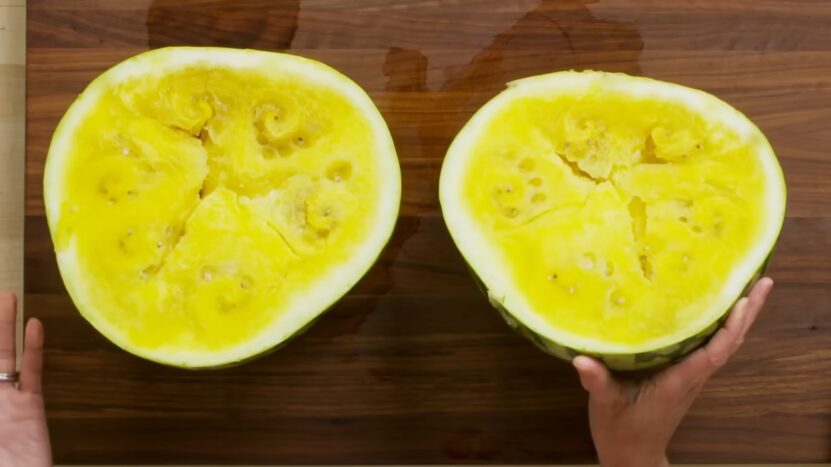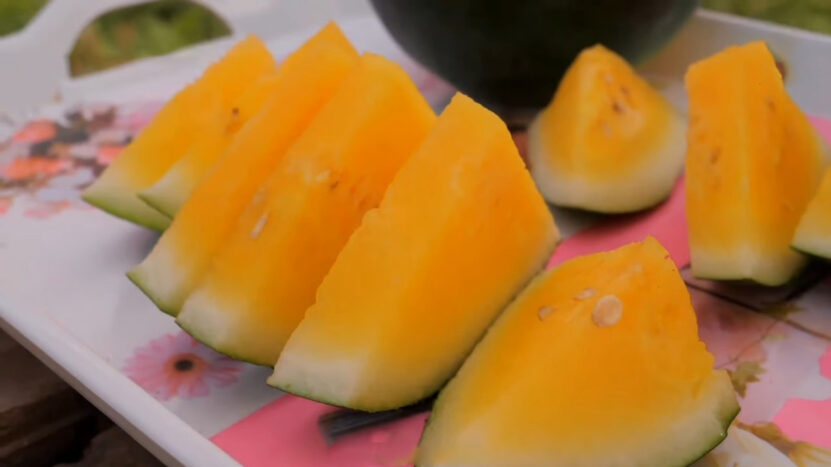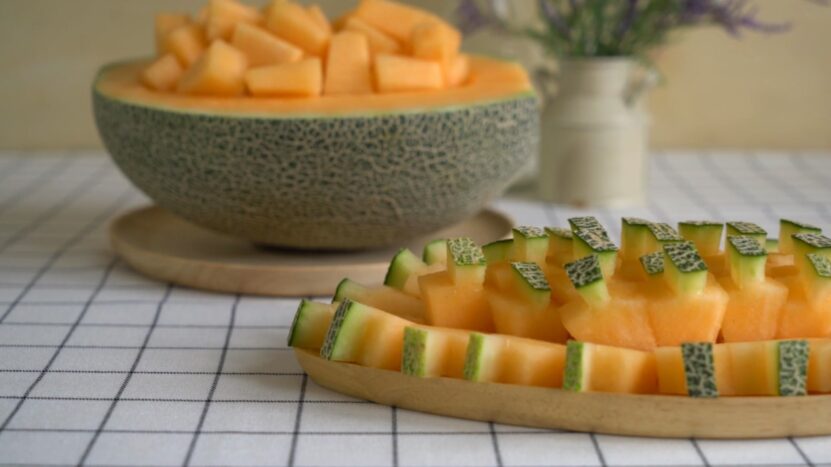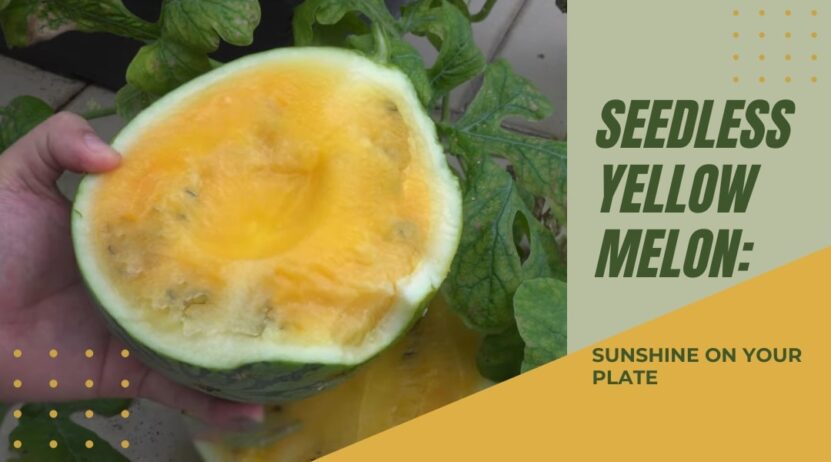When it comes to iconic summer fruits, watermelon undoubtedly takes center stage. Its vibrant pink flesh, juicy texture, and refreshing sweetness make it a staple at picnics, barbecues, and beach outings.
But what if we told you there’s a unique variation of this beloved fruit that combines the familiar delight of watermelon with a captivating twist? Enter the seedless yellow watermelon.
Usage
Seedless yellow watermelon is not only a feast for the eyes but also a versatile fruit that can be enjoyed in a variety of ways. Its unique color and flavor make it a fantastic addition to your summer culinary adventures. Here are some popular ways to incorporate seedless yellow watermelon into your menu:
- Fresh and Juicy: Slice the seedless yellow watermelon into wedges or cubes and enjoy it as a refreshing snack on its own. Its sweet and succulent flesh is perfect for hydrating and satisfying your taste buds on hot summer days.
- Fruit Salads: Add a pop of vibrant color and tropical sweetness to your fruit salads by including chunks or balls of seedless yellow watermelon. It pairs well with other fruits like berries, grapes, and citrus segments, creating a delightful medley of flavors.
- Smoothies and Juices: Blend seedless yellow with other fruits, such as strawberries, pineapple, or mango, for a refreshing and nutritious smoothie. Its natural sweetness and juicy texture make it an excellent base for summer beverages.
- Grilled Delights: Yes, you can grill ! Try grilling seedless yellow slices for a unique twist. The heat intensifies the sweetness and imparts a subtle smoky flavor, creating a tantalizing contrast between the warm exterior and cool interior.
- Salsa and Sides: Chop the seedless into small pieces and incorporate it into salsa recipes. The fruit’s juicy sweetness pairs well with ingredients like lime, cilantro, red onion, and jalapeño, adding a burst of flavor to your chips, tacos, or grilled meats. You can also use it as a side dish to accompany grilled seafood or BBQ favorites.
- Frozen Treats: Blend seedless yellow watermelon with a touch of lime juice and freeze it into refreshing popsicles or granitas. These icy treats are perfect for beating the summer heat and enjoying the unique flavor of seedless yellow in a frozen form.
Have you ever tried other kinds, like the Casaba melon? It doesn’t have the same intense flavor as the yellow one has, but i suggest you give it a try!
Selection

When it comes to selecting a seedless yellow watermelon, it’s essential to keep an eye out for certain indicators of ripeness and quality. Follow these tips to ensure you pick the perfect fruit:
- Color: Look for a vibrant, golden-yellow exterior. Avoid watermelons with a dull or pale appearance, as this may indicate underripeness.
- Shape and Weight: Choose a that feels heavy for its size. A ripe seedless yellow watermelon should have a symmetrical shape and feel dense when you lift it. This indicates a higher water content and juiciness.
- Texture: Gently press the skin of the. It should feel firm and taut, without any soft spots or indentations. Avoid that feel too hard or excessively soft, as they may be underripe or overripe, respectively.
- Field Spot: Check the underside of the watermelon, known as the field spot. It should have a creamy yellow color, indicating that the fruit ripened on the vine. Avoid ones with a green or white field spot, as they may not be fully ripe.
- Sound: Give the tap or thump with your knuckles. A ripe watermelon will produce a deep, hollow sound. If it sounds dull or flat, it may be underripe.
- Stem: Look for a watermelon with a dried, brown stem. A green or moist stem suggests that the fruit was harvested prematurely.
Avoid
To ensure you choose the best seedless yellow watermelon, watch out for the following signs of poor quality or underripeness:
- Dull or Faded Color: Avoid yellow watermelons with a dull or pale exterior. A vibrant, golden-yellow color indicates ripeness and sweetness.
- Soft or Mushy Texture: Gently press the skin and avoid those that feel overly soft or mushy. A ripe should have a firm and taut texture.
- Green or White Field Spot: Check the underside of the watermelon for the field spot. If it’s green or white instead of creamy yellow, it may indicate an underripe fruit.
- Mold or Decay: Inspect the surface of the for any signs of mold, decay, or soft spots. These are indicators of spoilage and should be avoided.
- Hollow Sound: Tap or thump the with your knuckles. A hollow, deep sound suggests ripeness, while a dull or flat sound may indicate an underripe fruit.
- Unpleasant Odor: Give the watermelon a sniff. A ripe yellow should have a sweet aroma. If it smells off or unpleasant, it may not be of good quality.
By avoiding watermelons with these characteristics, you can increase your chances of selecting a ripe, flavorful, and enjoyable yellow watermelon for your culinary adventures.
Here’s a video for tips on how to choose the right sweet melon:
Storage
Proper storage is key to maintaining the freshness and flavor of your seedless yellow watermelon. Follow these guidelines to keep your watermelon in optimal condition:
- Room Temperature: Whole, uncut seedless can be stored at room temperature for a short period, typically up to a week. Find a cool, well-ventilated spot away from direct sunlight.
- Refrigeration: For longer storage, place the seedless yellow in the refrigerator. Store it in the crisper drawer, which provides a slightly higher humidity level. Wrap the watermelon in a plastic bag or cover it with plastic wrap to prevent it from drying out.
- Cut Watermelon: If you’ve already cut into the, wrap the remaining portions tightly in plastic wrap or place them in an airtight container. Refrigerate them promptly and consume within 3-4 days for the best quality.
- Serving Temperature: Before enjoying your seedless , bring it to room temperature for the best flavor. This allows the fruit to regain its juiciness and enhances the eating experience.
- Avoid Freezing: Freezing seedless yellow watermelon is not recommended, as it can cause the texture to become mushy and affect the overall taste.
Ripening
After bringing home a seedless yellow watermelon, you may wonder how to ensure it reaches its peak ripeness. Here are some tips to help you with the ripening process:
- Room Temperature: Place the seedless yellow watermelon on a countertop or in a cool, well-ventilated area at room temperature. This allows the fruit to ripen gradually and develop its natural sweetness.
- Patience is Key: Unlike some fruits, seedless yellow do not significantly increase in sugar content after they are picked. It may take a few days to reach its optimal ripeness. Be patient and allow it the time it needs to develop its full flavor.
- Sensory Clues: Rely on your senses to assess the ripeness of the seedless yellow. Give it a gentle press – a ripe watermelon should yield slightly to pressure without feeling overly soft or mushy. Additionally, the exterior color should be vibrant and the skin should have a firm texture.
- Sound Test: Give the watermelon a tap or knock with your knuckles. A ripe seedless will produce a deep, hollow sound. If it sounds dull or flat, it may not be fully ripe yet.
- Harvesting Factors: Keep in mind that the ripeness of the at the time of purchase also plays a role. Choose a watermelon that is already showing signs of ripeness, such as a rich yellow color and a slightly sweet aroma.

Nutrition
Seedless yellow watermelon not only tantalizes the taste buds with its vibrant color and juicy sweetness but also offers a range of nutritional benefits. Here’s a closer look at the health benefits of incorporating this refreshing fruit into your diet:
- Hydration: With its high water content, seedless yellow watermelon is an excellent choice for staying hydrated, particularly during hot summer months. Staying properly hydrated is crucial for maintaining bodily functions, regulating body temperature, and supporting overall well-being.
- Vitamins and Antioxidants: Seedless is rich in essential vitamins, including vitamin C, which supports immune function and collagen synthesis. It also provides vitamin A, which is important for vision and skin health. Additionally, it contains antioxidants that help protect the body against harmful free radicals, contributing to overall health and well-being.
- Lycopene: Like its red counterparts, seedless yellow watermelon contains lycopene, a powerful antioxidant and pigment responsible for its vibrant yellow hue. Lycopene has been associated with numerous health benefits, including reduced risk of certain cancers and heart disease, as well as potential protection against sunburn.
- Potassium: Seedless yellow watermelon is a good source of potassium, an essential mineral that plays a vital role in maintaining proper heart function, regulating blood pressure, and supporting muscle and nerve function.
- Dietary Fiber: This fruit also provides dietary fiber, which aids in digestion, promotes feelings of fullness, and supports a healthy gut.
- Low in Calories and Fat: Seedless yellow is naturally low in calories and fat, making it a guilt-free and refreshing addition to a balanced diet.
If you’re a fan of sweet and spicy flavors Crenshaw melon will become your new addiction. Aside from numerous nutrition benefits, this type of melon is rich in vitamin A.
Tips & Trivia

- With an open palm, slap the watermelon. A high-pitched tone indicates green or under-ripe product. A dull sound or dead thud indicates an over-ripe melon. A deep-pitched tone indicates a melon that is ripe. Slap a number of melons one after the other and
- Small melons are the hardest to test for ripeness since most will sound green even if they are ripe. If you need a small amount of watermelon, it is best to buy a piece of a larger one. It may be more expensive per pound, but you will be more likely to ge
- Melons may be kept at room temperature, un-cut, for about two weeks. Store whole melons at 50-60°F. Cut melons should be wrapped and stored at 40-50°F.
- Watermelon, considered one of America’s favorite fruits, is really a vegetable (Citrullus lanatus). Cousin to the cucumber and kin to the gourd, can range in size from 7 to 100 pounds. The world record for the largest grown is 255 pounds, grown by Vernon Conrad of Bixby, Oklahoma!
- Historians say first grew in the middle of the Kalahari Desert. They were a source of water for thirsty traders, who began to sell the seeds in cities along the ancient Mediterranean trade routes.
- Cultivation of watermelon spread throughout Africa and, by the 1600s, watermelon made its way to Great Britain, Spain, China and beyond. Watermelon arrived in North America courtesy of European colonists and African slaves.

